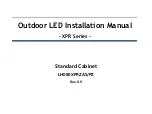
Point Grey Flea3 GigE Technical Reference
8 Flea3 GigE Attributes
8
Flea3 GigE Attributes
8.1
Pixel Formats
Pixel formats are an encoding scheme by which color or monochrome images are produced from raw image data. Most
pixel formats are numbered 8, 12, or 16 to represent the number of bits per pixel.
The Flea3 GigE's
Analog-to-Digital Converter,
which digitizes the images, is configured to a fixed bit output (12-bit). If the
pixel format selected has fewer bits per pixel than the ADC output, the least significant bits are dropped. If the pixel
format selected has greater bits per pixel than the ADC output, the least significant bits are padded with zeros.
Pixel Format
Bits per Pixel
Mono 8, Raw 8
8
Mono 12, Raw 12, YUV 411
12
Mono 16, Raw 16, YUV 422
16
RGB 8, YUV 444
24
8.1.1
Raw
Raw is a pixel format where image data is Bayer RAW untouched by any on board processing. Selecting a Raw format
bypasses the FPGA/color core which disables image processing, such as gamma/LUT and color encoding, but allows for
faster frame rates.
8.1.2
Mono
Mono is a pixel format where image data is monochrome. Color cameras using a mono format enable FPGA/color core
image processing such as access to gamma/LUT.
Y8 and Y16 are also monochrome formats with 8 and 16 bits per pixel respectively.
8.1.3
RGB
RGB is a color-encoding scheme that represents the intensities of red, green, and blue channels in each pixel. Each color
channel uses 8 bits of data. With 3 color channels, a single RGB pixel is 24 bits.
8.1.4
YUV
YUV is a color-encoding scheme that assigns both brightness (Y) and color (UV) values to each pixel. Each Y, U, and V
value comprises 8 bits of data. Data transmission can be in 24, 16, or 12 bits per pixel. For 16 and 12 bits per pixel
transmissions, the U and V values are shared between pixels to free bandwidth and possibly increase frame rate.
YUV444 is considered a high resolution format which transmits 24 bits per pixel. Each Y, U, and V value has 8 bits.
YUV422 is considered a medium resolution format which transmits 16 bits per pixel. Each Y value has 8 bits, but the U
and V values are shared between 2 pixels. This reduces the bandwidth of an uncompressed video signal by one-third
with little to no visual difference.
Revised 10/29/2013
Copyright ©2010-2013 Point Grey Research Inc.
52
















































